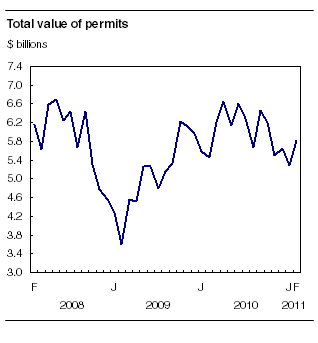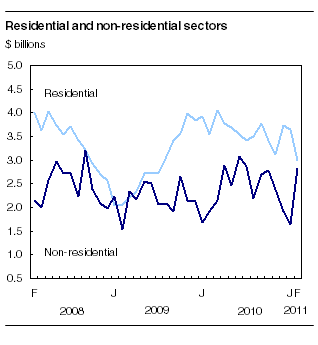
 April 7, 2011 – Municipalities issued building permits worth $5.8 billion in
April 7, 2011 – Municipalities issued building permits worth $5.8 billion in
February, up 9.9 per cent from January. The February advance was a result of
gains in the non-residential sector in Alberta and Ontario, which more
than offset the decline in the residential sector.
April 7, 2011 – Municipalities issued building permits worth $5.8 billion in
February, up 9.9 per cent from January. The February advance was a result of
gains in the non-residential sector in Alberta and Ontario, which more
than offset the decline in the residential sector.
In the non-residential sector, the value of permits
totalled $2.8 billion in February, up 72.9 per cent compared with January.
Alberta and Ontario accounted for much of the growth at the national
level. In February, five other provinces also posted gains in the
non-residential sector.
In contrast, the value of residential permits fell 18.3 per cent
to $3.0 billion in February. The decrease was attributable to both
multi-family and single-family dwellings. Ontario and Quebec registered
the largest declines.

|
|
Non-residential sector: Gains in all three components
Industrial construction intentions increased to a
record $884.4 million in February. The gain occurred as a result of
higher construction intentions for transportation-related buildings in
Alberta and manufacturing plants in Ontario.
Revised data, based on late responses, are updated for the previous
month.
In the institutional component, the value of permits issued by
municipalities doubled to $702 million, following four consecutive
monthly declines. The increase in February came from seven provinces,
led by Ontario. The gain in Ontario was attributable to higher
construction intentions for government administrative buildings.
In the commercial component, the value of permits rose 22.6 per cent
to $1.2 billion. The gain in February followed three consecutive monthly
declines. In February, seven provinces contributed to the increase,
through various types of buildings, including hotels, retail stores and
warehouses.
Residential sector: Declines in single-family and multi-family dwelling intentions
Construction intentions for multi-family dwellings fell 34.4 per cent
to $892 million in February. This was the first time in a year that the
value of multi-family permits fell below the billion-dollar mark. The
decline was attributable to decreases in five provinces, particularly
Ontario and Quebec.
The value of building permits for single-family dwellings fell 8.6 per cent
to $2.1 billion, following three consecutive monthly gains. The February
decrease was a result of declines in six provinces, led by Ontario,
Quebec and Alberta.
At the national level, municipalities approved the construction
of 13,488 new dwellings in February, down 24.6 per cent. The decrease was
largely attributable to multi-family dwellings, which fell 36.6 per cent
to 6,690 units. Single-family dwellings declined 7.3 per cent to 6,798 units.

|
|
Value of permits up in half the provinces
In February, the value of building permits was up in five provinces, led by Alberta.
Alberta posted large gains as a result of increases in permits for
the industrial, commercial and institutional components. British
Columbia, Manitoba and Prince Edward Island also recorded increases in
February, as a result of higher values of building permits in the
non-residential sector.
The largest decreases occurred in Quebec and Ontario. The decline was
attributable to permits for both multi-family and single-family
dwellings.
Higher permit values in most census metropolitan areas
The total value of permits was up in 23 of the 34 census metropolitan areas in Canada.
The non-residential sector was responsible for increases in Calgary, London, Kitchener–Cambridge–Waterloo and Edmonton.
The largest declines were in Montréal, Toronto, Regina and Ottawa. In
Montréal, the decrease was primarily a result of a decline in
multi-family and non-residential permits, which had posted a significant
increase in January. In Toronto, the decline was mainly attributable to
a drop in the residential sector, which more than offset the gain in
the non-residential sector. In Regina and Ottawa, the decrease came from
both the residential and non-residential sectors, following large gains
in January.
Print this page
Leave a Reply